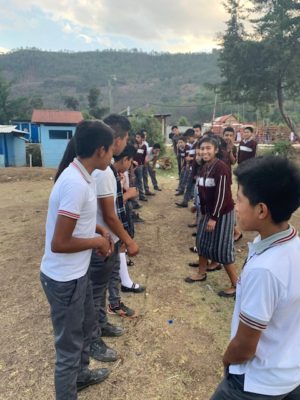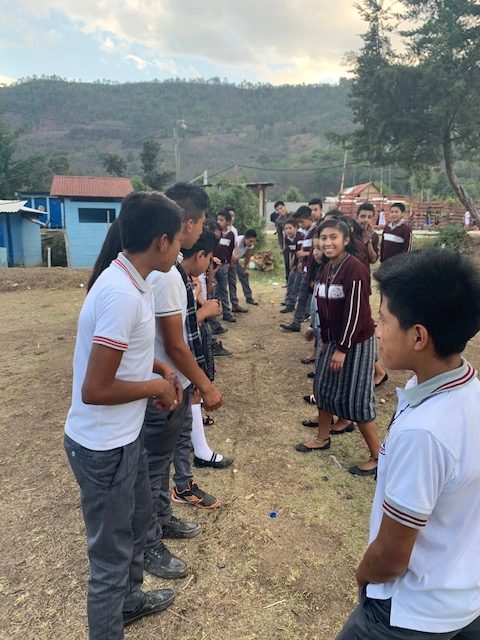
Mayans represented a majority – about 83% – of the over 200,000 people killed in the Guatemalan civil war (1960-1996). Guatemalan Coalition member International Institute of Learning for Social Reconciliation (IIARS) hosts forums in communities to confront this painful history and pave the path toward reconciliation. With a focus on combating racism and social exclusion, they are currently working with five schools in the El Quiché area with students between the ages of 13 and 17 to strengthen their civic engagement skills and understanding. In El Quiché, 88% of the population is Mayan, a demographic that continues to suffer from extreme poverty and social-political marginalization in Guatemala. El Quiché is also one of the regions with the highest levels of migration in Guatemala with an estimated 7% of the population migrating internationally every year. In 2019, the Coalition awarded IIARS a Project Support Fund grant for Migration Dialogues, an innovative project that integrates photography, film, music and dialogue into workshops with the goal of educating communities about the economic, physical and psychological challenges of migration and to offer concrete alternatives.
“Over the past year, at least 20 students and educators have left due to migration,” explain Vivian Salazar Monzón and Silvia Romero, respectively the Executive Director and Education Coordinator at IIARS. “During the same time, IIARS facilitators observed that the quality of education is suffering due to the scarcity of personnel; students’ mental health is declining; and there are increasing rates of alcoholism and depression in the schools. Despite these negative impacts, facilitators have observed that youth have a favorable, romanticized view of migration. The youth in El Quiché see migration as something they should attempt to undertake, but they are not sufficiently aware of the risks involved.”

There are many risks associated with migrating, including assaults, robbery, gendered and sexual violence, economic instability as well as labor exploitation. To counter the dangerous myths surrounding migration, IIARS will use their Project Support Fund grant to install a photographic exhibit entitled “Migrar es un derecho, no migrar también lo es” or “Migrating is a right, not migrating is also a right” in a community center within Cunén, a town in El Quiché, and will host youth dialogue programs. Curated by La Mesa Nacional de Migración, a coalition of organizations focused on addressing migration in Guatemala and an IIARS partner, the exhibit is comprised of 16 panels that invite viewers to reflect on the many factors that force people to migrate, the difficulties in leaving home, and the problems associated with returning. The exhibit represents the work of several professional photographers and includes photographs of activists who have accompanied and documented migration in the last few years.
After the exhibit is installed in the Cunén community center, IIARS will host and facilitate dialogues about migration with youth, assisting them in identifying how the civil war and other motivations have influenced migration rates and related social issues, like access to health care. “The program is grounded in participatory learning and will use the exhibit to generate questions and reflection about migration in Guatemala and students’ lives more personally,” explain Monzón and Romero. “IIARS aims to help students express themselves while they learn more about the nuances of migration and the risks associated with it.” To this end, forty students will also be engaged in a workshop to create rap songs about migration and its complexities.

“IIARS believes art can be a helpful tool to stimulate the expression of ideas, especially with youth. We have seen the power of using art to stimulate reflection and deepen ideas on community issues – from gender equity to environmental threats. In past workshops, students in El Quiché expressed interest in using music more. Writing and using rap is one more tool for students to share their opinions, ask questions, and delve deeper into complicated socio-political issues,” add Monzón and Romero.
As another component of this project, IIARS will create a short film that compiles personal narratives and responses to the exhibit with visitors of all ages who have agreed to share their thoughts on it. IIARS hopes the video will become another tool to engage young people about the issue and consequences of migration on communities around the country.

The exhibit will complement IIARS’ permanent exhibit in Guatemala City called “Why We Are Who We Are?” or “Por qué estamos como estamos?,” which opened in 2009 and has had over 250,000 visitors. “The exhibit has been quite successful in catalyzing dialogue with school groups, teachers, families and other populations to examine the historical legacies of polarizing social issues and their present-day manifestations, but many populations outside of the capital city have a hard time visiting.” To avoid this problem with “Migrar es un derecho, no migrar también lo es,” the new exhibit will be designed to be mobile so that after its time in El Quiché it can travel to other municipalities. “This traveling aspect of the exhibit will create even more opportunities for IIARS to catalyze dialogue and strengthen education around the complexities of migration,” report Monzón and Romero. “The impact will be far and wide.”

